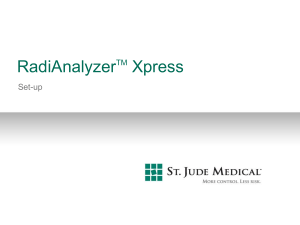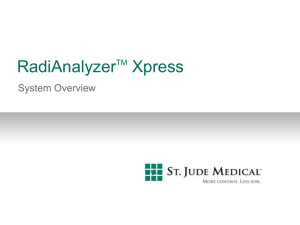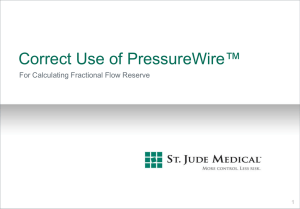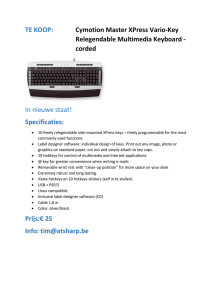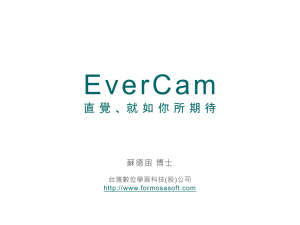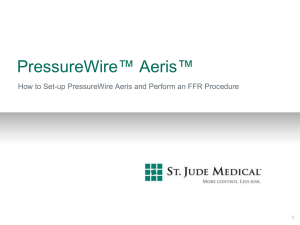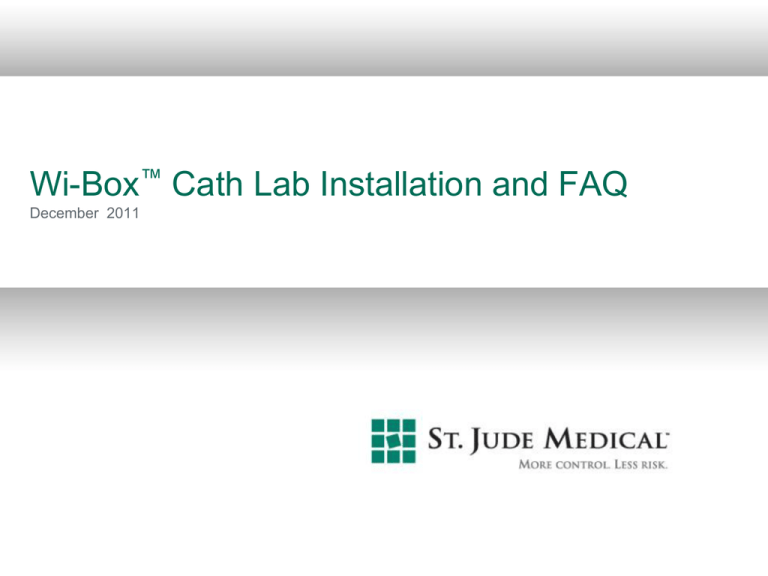
Wi-Box™ Cath Lab Installation and FAQ
December 2011
Wi-Box Ordering Specifics
Wi-Box
Wi-Box Power Supply Kit
C12783
C12785
Cables:
Adapter cable (x1)
Monitor cable (x1)
Xpress to Wi-Box cable
126XX
129XX
C12784
Refer to CVD product catalogue for a complete listing of recording systems and adapter/monitor cables
(126XX and 129XX series are the same as for current RadiAnalyzer™ Xpress)
Top Recording Systems
Adapter cables
Monitor cables
Siemens Sensis 10 pin
12601
12901
Siemens Sensis 7 pin
12649
12901+12849
GE Mac-Lab™
12618
12918
Philips Xper or Witt series 4/5
12648
12948
Philips Xper Flex Cardio
12616
12916
Philips (Schwarzer)
12660
12960
McKesson/Merge/Picasso Cables V1
12651
12951
McKesson/Merge/Picasso Cables V2
12664
12964
Installation
General
3
The Wi-Box is permanently installed underneath the cath lab table on a vertical, flat surface with the
connectors facing down to avoid fluid contamination and bending of cable connectors
Make sure to clean the underlying mounting surface with alcohol before attaching the Wi-Box
Make sure the connecting cables are not strained when the cath lab table is moved – test moving
the table to its extreme positions after installation
Install one Wi-Box in each room where ILUMIEN™ PCI Optimization System, RadiAnalyzer Xpress
or any other compatible St. Jude Medical FFR/OCT system may be used to measure FFR
Connecting cables (adapter and monitor cables) are ordered according to the specific hemodynamic
recording system in each room
Installation
1. Mount Wi-Box on cath lab table floor column
Remove the protective cover on the
adhesive surface on the back of Wi-Box
Attach Wi-Box by pushing it firmly toward
the surface with the connectors facing down
Make sure to clean the surface with alcohol
before attaching Wi-Box
4
Installation
2. Connect to AO transducer and hemodynamic recording system
1. Connect the AO transducer cable to the Adapter cable (Art No: 126XX)
2. Connect the adapter cable to the AO IN connector on the Wi-Box
3. Use the Monitor cable (Art No: 129XX) to connect AO OUT to a free
pressure channel on the hemodynamic recording system
4. AO pressure may be zeroed per standard cath lab procedure on the
hemodynamic recording system
Adapter cable
AO transducer
5
Recording System
AO transducer cable
Installation
3. Perform function control
1.
2.
3.
4.
Verify that the AO transducer is connected to AO IN
Verify that AO OUT is connected to a pressure channel on the recording system
Zero the pressure channel on the hemodynamic recording system
Check if the green “READY” light on the Wi-Box is lit
YES:
Wi-Box is powered by the hemodynamic recording system and is ready for use
NO: The red “NOT READY” light is lit
The power from the hemodynamic recording system is too low, Wi-Box requires a power supply to
function (sold separately)
NO: Neither the READY nor NOT READY lights are lit
There is an error with either the Wi-Box or with the cables, replace Wi-Box and cables
6
Installation
4. If required, connect the Wi-Box power supply
Note: If the Wi-Box requires a power supply, it is not possible to use Wi-Box with RadiAnalyzer Xpress
1.
2.
3.
4.
Connect the power supply instrument plug to the “XPRESS/PSU” socket on the Wi-Box
Connect the power supply to mains
Verify that the white and green indicators are lit
If the red “NOT READY” light is still lit, an internal error has occurred and the unit must be replaced
Order Number for Wi-Box PSU Kit: C12785
7
Link Wi-Box with ILUMIEN System
(Before first FFR procedure)
Link Wi-Box with ILUMIEN
The Wi-Boxes in each room are the source of AO pressure
AO pressure and PressureWire™ Aeris™ enable ILUMIEN to
measure pressures and calculate FFR
Each Wi-Box in all rooms must be linked to a unique room setup
profile on the ILUMIEN console
It is important to make sure that the correct Wi-Box is linked to the
correct room
If a Wi-Box is moved to another room, the room profile on the
ILUMIEN console must be updated with the new room
IMPORTANT
To simplify identification of each Wi-Box, it is advisable to power
off all Wi-Boxes by disconnecting them from the cath lab recording
system until they are being linked with ILUMIEN.
9
Link Wi-Box with ILUMIEN
1. Check Wi-Box and
Turn on ILUMIEN
Verify “Ready” light
on Wi-Box
Turn on ILUMIEN system
Hibernate/Wake-up button on
upper right of keyboard
NOTE: If the system is in hibernate
mode, the power indicator light on
the monitors will be amber.
Main switch next to power cable
10
Link Wi-Box with ILUMIEN
2. Create Test Patient
11
Link Wi-Box with ILUMIEN
3. Link Wi-Box with a room profile on ILUMIEN
a) Verify that the Wi-Box on screen has an identical
serial number as the Wi-Box physically installed in
the current room
b) Identify room by name and number
12
Link Wi-Box with ILUMIEN
4. Repeat 1-3 for all rooms and Wi-Boxes
a) Use the previously entered test patient when setting
up all rooms
b) Delete the test patient when done
ILUMIEN
13
Starting an FFR Case with
Wi-Box™ Solution and
RadiAnalyzer™ Xpress
FFR Procedure with Wi-Box and RadiAnalyzer Xpress
Roll in RadiAnalyzer Xpress and connect to Wi-Box
1. Roll in and turn on RadiAnalyzer Xpress
2. Connect the RadiAnalyzer Xpress Wi-Box cable between
AO IN on RadiAnalyzer and XPRESS/PSU on Wi-Box
Note: To enable PressureWire reading on the recording system, a cable may be
connected between PW OUT on RadiAnalyzer Xpress to the recording system. It is
recommended to omit this cable for mobile RadiAnalyzer Xpress usage in order to
simplify FFR workflow.
AO transducer
RadiAnalyzer Xpress AO IN
AO transducer cable
Recording System
Adapter cable
FFR Procedure with Wi-Box and RadiAnalyzer Xpress
Zero AO on RadiAnalyzer Xpress
1. Select CAL AO(Pa) and press ENTER
2. Open AO transducer to air and press ENTER
Note: If the Auto Setup sequence is activated, the first step (Zero cathlab)
must be skipped by pressing ENTER on the remote control
FFR Procedure with Wi-Box and RadiAnalyzer Xpress
Cal PressureWire
1. Select CAL WIRE(Pd) and press ENTER
2. Flush the PressureWire packaging coil, place flat and press ENTER
Note: If the Auto Setup sequence is activated, the first step (Zero cathlab)
must be skipped by pressing ENTER on the remote control
FFR Procedure with Wi-Box and RadiAnalyzer Xpress
Equalize and record FFR (Same procedure as without Wi-Box)
1. Advance PressureWire until its pressure sensor is placed at the opening of the guide
catheter
2. Flush catheter from contrast and make sure to close all valves, remove wire introducer
3. Equalize AO and PressureWire pressures using the Equalize function on the
RadiAnalyzer Xpress
4. Advance PressureWire to region of interest
5. Induce hyperemia per standard cath lab protocol
6. Press Rec to record pressure, press stop to review recording and FFR
Refer to instructions of use for RadiAnalyzer Xpress for full FFR or CFR procedure
instructions.
Using Wi-Box and RadiAnalyzer Xpress with
the Auto Setup Sequence
1. Press ENTER to skip first step and
continue
2. Open AO transducer to air and
press ENTER
3. Flush the PressureWire packaging
coil, place flat and press ENTER
Note: If PW OUT on the RadiAnalyzer Xpress is connected to the cath lab recording
system, the first step is necessary to balance RadiAnalyzer Xpress PW OUT with PW IN
on hemodynamic recording system
Miscellaneous
Re-Zero AO pressure transducer
If the AO pressure transducer needs to be re-zeroed during the case, both the AO IN on
RadiAnalyzer Xpress and the AO pressure channel on the hemodynamic recording system
need to be zeroed:
1. Open AO transducer to air
2. Zero AO on RadiAnalyzer Xpress
3. Zero AO on hemodynamic recording system
Note: The order of steps 2 and 3 is not important.
Wi-Box FAQ
For use with ILUMIEN and RadiAnalyzer Xpress
Wi-Box FAQ
Q: Since the Wi-Box is permanently placed between the AO transducer
and the hemodynamic recording system, is there a risk for erroneous
readings, inaccuracy or time delay?
Answer:
The Wi-Box is an electrical circuit “listening” to the pressure from the connected
AO transducer and transmitting the pressure via radio to a receiver.
Electrically, the AO transducer is still directly hardwired to the hemodynamic
recording system through the Wi-Box.
The Wi-Box does not change the accuracy of the pressure read by the
hemodynamic recording system.
There is no time delay through the Wi-Box; if one pressure is passing through the
Wi-Box and one is directly connected to the recording system, there is no
difference in time delay between the two pressure readings.
22
Wi-Box FAQ
Q: Since the Wi-Box is permanently placed between the AO transducer
and the hemodynamic recording system, is there a risk for AO failure
during normal cath lab operation – not involving ILUMIEN or
RadiAnalyzer Xpress?
Answer:
The Wi-Box is designed with a direct, hardwired connection between the AO
transducer and the hemodynamic recording system.
Even in the unlikely event that the software or electronics in the device would
fail, the AO pressure is still passed straight through the device to the recording
system.
Pressure is still passed through the Wi-Box, even without power supply.
If for any reason the user wishes to disconnect the Wi-Box, simply unplug the
AO transducer cable from the adapter cable and plug it straight into the
hemodynamic recording system, bypassing the Wi-Box.
23
Wi-Box FAQ
Q: With the Wi-Box between the AO transducer and the hemodynamic
recording system, how does the lab zero the AO pressure during a
case that does not involve FFR?
Answer:
The AO pressure is zeroed exactly as it is without the Wi-Box – by opening
the AO transducer valve to air and zeroing the corresponding pressure
channel on the hemodynamic recording system
24
FAQ Wi-Box
Q: On some recording systems, an arbitrary pressure value can be seen onscreen when the AO transducer is disconnected from the Wi-Box – why?
Answer:
Some hemodynamic recording systems automatically detect when an AO transducer is
disconnected. This enables the system to stop displaying pressure when the AO transducer is
disconnected after a case, between patients.
With the Wi-Box always connected to the pressure port, the hemodynamic recording system
may not detect when the AO transducer is disconnected and will keep displaying pressure
coming in from the Wi-Box.
Without an AO transducer connected, the pressure reading from the open-ended connector will
be an arbitrary, random, pressure value.
This phenomenon does not affect the pressure reading when there is an AO transducer (with a
patient) connected; the problem is limited to possible confusion when seeing an arbitrary
pressure value on the screen between cases.
If, for any reason, the user wishes to disconnect the Wi-Box, they can simply unplug the AO
transducer cable from the adapter cable and plug it straight into the hemodynamic recording
system, bypassing the Wi-Box.
25
Wi-Box FAQ
Q: Can the Wi-Box transmit AO pressure to ILUMIEN at the same
time it is connected to a RadiAnalyzer Xpress?
Answer:
Yes, Wi-Box is capable of simultaneously providing AO pressure to ILUMIEN
and RadiAnalyzer Xpress if they are used in the same room at the same
time.
However, if a power supply unit is required to operate the Wi-Box, it is not
possible to also connect to a RadiAnalyzer Xpress, since the power supply
unit uses the same port.
26
Wi-Box FAQ
Q: Why is a power supply sometimes required and sometimes not?
Answer:
The Wi-Box is designed to work using only the excitation voltage provided by the
invasive pressure port on the hemodynamic recording system, without the need
for an additional power supply.
Some combinations of recording systems and AO transducers may limit the
available power to the Wi-Box; if this occurs the NOT READY light on the Wi-Box
will light up after the AO transducer is connected. In this case, an additional
Power Supply unit is required to power the Wi-Box.
Electrical power requirements
Power Input: 2.4 to 8 VDC
For 2.4 to 4 VDC, use Wi-Box External Power Supply
Electrical requirements AO transducer:
Input impedance >270 Ohm
For complete technical specifications, refer to the Wi-Box IFU.
27
Wi-Box FAQ
Q: What troubleshooting steps should be performed if the AO
pressure is not identical on the ILUMIEN/RadiAnalyzer Xpress and
the hemodynamic recording system?
Answer:
1. Open the AO transducer to air
2. Zero AO pressure on ILUMIEN or RadiAnalyzer Xpress
3. Zero pressure on hemodynamic recording system
4. Close AO transducer to air to resume pressure reading
28
Wi-Box FAQ
Q: How does the Wi-Box connect with ACIST or similar contrast
injectors with a built in AO transducer?
Answer:
The Wi-Box always connects between the AO transducer and the cath lab
recording system
If there is a ACIST device, Wi-Box connects between its AO transducer and
the hemodynamic recording system
ACIST with
AO transducer
Hemodynamic Recording system
Wi-Box
Adapter Cable
29
Monitor Cable
Secure Radio Technology
PressureWire Aeris and Wi-Box utilize advanced radio technology to ensure a stable and secure
communication with ILUMIEN/Xpress and to avoid disturbing other systems.
1. Transmitters (Aeris and Wi-Box) and Receivers (inside ILUMIEN) lock to each other using unique identification
codes stored in the transmitters
2. The Receiver stores the last connected transmitter in its memory
3. In the event of power failure, the Receivers resume communication automatically
4. The system utilizes “Frequency-Hopping Spread Spectrum” technology (FHSS) and changes transmitting
frequency randomly at 400 times/s
5. The technology minimizes the risk of interference with, or disturbance from, other systems in the cath lab
6. Very low radio power further reduces risk of interfering with other systems
PressureWire USB Receiver
PressureWire Aeris Transmitter
400 hops/s
79 channels
AO USB Receiver
Wi-Box Transmitter
30
Radio Technology FAQ
Q: Can the radio signal be disturbed by mobile phones, Wi-Fi networks,
X-ray, etc?
Answer:
No. PressureWire Aeris and Wi-Box utilize an advanced radio technology called
"frequency hopping" where the information is sent several times using multiple
radio frequencies.
The system changes radio frequency 400 times per second, which means that
even if there are several interfering radio sources, the signal will reach the
receiver on other frequencies
Extensive, real-life cath lab testing has been performed without interruption of
radio communication
31
Radio Technology FAQ
Q: Can PressureWire Aeris or Wi-Box cause disturbances to other
cath lab systems?
Answer:
PressureWire Aeris and Wi-Box are designed to interfere as little as possible with
other radio devices
The transmitted radio power is very low - max 1 mW (0.001) and average 70 μW
(0.000070), which is 1000 to 10.000 times lower than the power from a normal
cellular phone
The frequency-hopping technique further reduces the risk by transmitting on
each frequency for only a very short time
The lead enclosure in cath labs reduces the amount of radio power emitted from
inside the cath lab.
PressureWire Aeris and Wi-Box have passed all radio acceptance tests by US
FCC and EU R&TTE.
32
Radio Technology FAQ
Q: Can several pairs of PressureWire Aeris/Wi-Box and
ILUMIEN/Receivers be used at the same time in the same environment?
Answer:
Yes. At the start of a procedure, PressureWire Aeris and Wi-Box lock to ILUMIEN
using a built-in unique identifier code
ILUMIEN can only receive pressure from one connected PressureWire Aeris and
one Wi-Box regardless of any other devices used in the same environment
The frequency-hopping scheme is random, which means that several pairs of
PressureWire Aeris, Wi-Boxes and ILUMIEN systems can communicate in the same
environment without disturbing each other
33
Rx Only
Please review the Instructions for Use prior to using these devices for a complete listing of indications,
contraindications, warnings, precautions, potential adverse events and directions for use.
PressureWire Aeris, Wi-Box and RadiAnalyzer are designed, developed and manufactured by St. Jude
Medical Systems AB. ILUMIEN, PressureWire, Aeris, RadiAnalyzer, Wi-Box, LightLab, ST. JUDE
MEDICAL, the nine-squares symbol and MORE CONTROL. LESS RISK. are registered and
unregistered trademarks and service marks of St. Jude Medical, Inc. and its related companies. MacLab is a registered or unregistered trademark or service mark of GE Healthcare. ©2011 St. Jude
Medical, Inc. All rights reserved
IPN 1830-11
34

